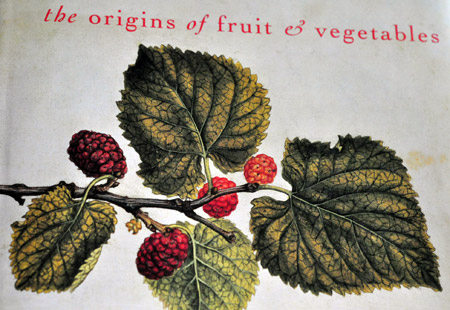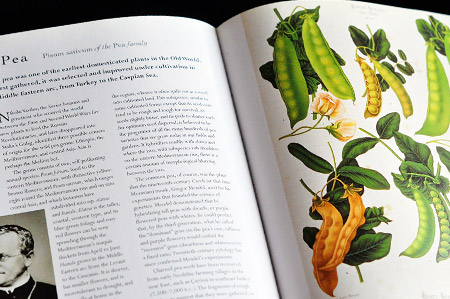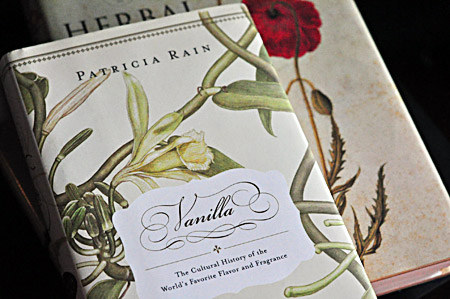
Have you ever heard of sea cabbage, a wild cousin of the domesticated brassicas? Did you know that edible bananas are a primitive plant thought to be related to some of the first trees of the primeval forest?
I didn’t either until this weekend when I was finishing up an article on unusual vegetables and decided to fact check some long-ago gleaned historical knowledge against books in my personal library. What began as a quick check turned into a much longer read.

The first book I pulled out is called The Origins of Fruit and Vegetables by Johnathan Roberts (in case you’re wondering mine cost $22US, not $472 YIKES). I think I’ve had this book in my possession since it was first published in 2001, and while I have flipped through the pages of historical prints and food-based artwork more than once, I’m not certain of just how much I have actually read. If you’re interested in plant history and ethnobotany, this book is a great place to start. It’s not exactly a definitive tome on the subject but it’s a beautiful book that provides just enough insight to draw you into searching out more. It also gives you something to talk about in mixed company. Now if only they’d make a gardener’s trivial pursuit for geeks like me.

Next week I am off on a month long journey to The Caribbean. As you can imagine I am extremely excited about food and plants. One of the plants I am most stoked about seeing up close and personal is the vanilla orchid. I have actually seen the vining plant growing in the greenhouse of a botanical garden, but I have never seen one growing outdoors and in bloom nor smelled the scent of its flowers. Or touched a green pod straight off the plant for that matter. Everything about the vanilla from its history to the process of growing and fermenting the beans fascinates me to no end. I found a book at a used bookstore last week that indulges everything one could want or need to know about vanilla. I plan to read it during the first part of my trip to get in the mood to see vanilla towards the end. Vanilla: The Cultural History of the World’s Favorite Flavor and Fragrance, written by Patricia Rain, the self-proclaimed Queen of Vanilla is indeed what I would call a definitive tome on the subject, covering everything including a sampling of interesting new ways to use vanilla in cooking. If the beans are affordable and customs allows me to bring some back, I plan to get a whole bunch as gifts for friends. I’d also like to try my hand at making homemade vanilla extract to give as gifts. I am after-all going to be visiting places known for both decent rum and vanilla production. I should be able to produce a quantity of excellent extract affordably. I think I’m going to need bigger luggage.
A third book, one that I have gone to many times and have even posted about here is Herbal: The Essential Guide to Herbs for Living by Deni Bown. I bought my copy back in 2002 after much deliberation. At $58.00 the book is not exactly cheap but I promise you it is worth the dough if you are curious about the historical background and usage of the herbs you like to grow or are seeking inspiration to try a few exotics. The book does contain some growing information but is not meant as a gardening primer. I’d suggest Exotic Herbs by Carole Saville, or New Book of Herbs by Jekka McVicar if you’re looking for more definitive growing considerations for a wide variety of common and unusual herbs.
Yeah, I can’t say I really spend a lot of time reading my plant books…I mostly use them for reference in emergency situations…
GartenGrl
I love reading plant books, and ethnobotany was one of my favorite courses at university. I’ll be sure to check these out. Great update!
I spoke to someone living in St. Lucia tonight and the vanilla beans are ridiculously expensive… $10US per bean! Yikes! I can get beans from Mexico 3 for $10 CDN here.
Hmmm,I wonder if the vanilla beans are so expensive because they count on exporting them?
I got a half pound of organic beans for $20-something and there must be 30 beans in the bag!
Hopefully you can find a good source for much less!?
I guess that’s because the St. Lucia plants have to be hand pollinated. Vanilla is native to Mexico and is pollinated by hummingbirds,
Renee: I’m not going to worry about it. I’m most excited about seeing the plant and the process.
Barry: The book says there is hand-pollination in Mexico as well.
Wow, that ‘Origins’ book sounds like catnip to me… actually, they all sound fantastic. Great cocktail party nuggets.
Where did you find it for $22?
Daedre: $22 US was the original cover price. I’m guessing it has gone out of print and there were probably only a limited number made. I checked the current price AFTER I started writing the post and might not have posted had I known… because how insane!! That said, it’s still good to know in case you happen upon it used in a thrift store or bookstore for a normal price. I will certainly keep my eyes open.
“Now if only they’d make a gardener’s trivial pursuit for geeks like me”.
That sounds like a fun project and a nice break from book writing for someone. :)
Alurien: Is it you?
“Now if only they’d make a gardener’s trivial pursuit for geeks like meâ€Â.
Jump on that one quick, because if it isn’t you, it’s someone. Oh, god. What fun that could be!
This was really interesting, but I too grasped onto “Gardener Trivial Pursuit” – I’d buy it in a hearbeat!
Gayla, On the vanilla story, came across this info on the website for the Muttart Conservatory in Edmonton:
* The fact that only one species of bee can successfully pollinate vanilla orchids presents a problem to growers outside of the orchids’ native habitat. Growers rely on artifical pollination.
Perhaps this bee is native to the area of Mexico near Vera Cruz where the orchid was first cultivated – and might be why they must be hand pollinated, even in other parts of that country.
The full resource note can be seen here:
http://www.muttartconservatory.ca/pages/Muttart/Resource.aspx?id=344